|
| Links | Note: This common eastern species has had a history of name changes, which I am truncating and taking shortcuts with here. Originally described as L. atlanticum by Mitchell, it was rarely identified in collections due to Mitchell's sparse Lasioglossum key. Later Gibbs redescribed the species and then had to rename it due to a conflict with another name in the same genus to L. mitchelli. Later it was discovered that this also conflicted with another name in another country and it was change to the present L. hitchensi.
The species is relatively small and is characterized by a complete T1 fan, a very subtly squared-off clypeus, where the straight portion of the rim takes up a greater proportion of the distance between the eyes than most other species, and has pitting on T2 that heavily to the rim.
- Hosts
|
80x5 -
240x3 -
240x4 -
320x1 -
320x2 -
320x3 -
640x1 -
640x2
Set display option above.
Click on
images to enlarge. |
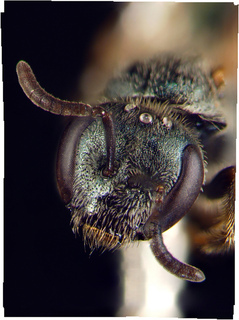
Ellen Bulger · 9
Lasioglossum hitchensi |
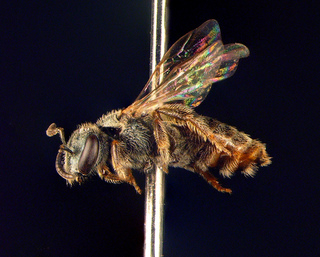
Ellen Bulger · 9
Lasioglossum hitchensi |
|
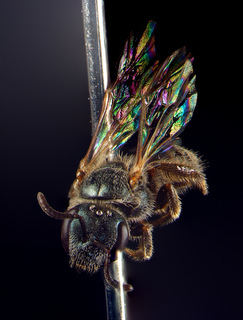
Ellen Bulger · 8
Lasioglossum hitchensi |
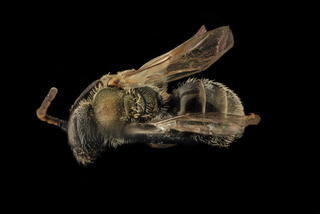
© Copyright source/photographer
· 5
Lasioglossum hitchensi, Back, MD, St Marys County |
|
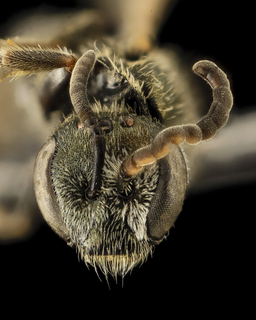
© Copyright source/photographer
· 5
Lasioglossum hitchensi, Face, MD, St Marys County |
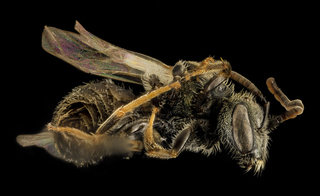
© Copyright source/photographer
· 5
Lasioglossum hitchensi, Side, MD St Marys County |
|
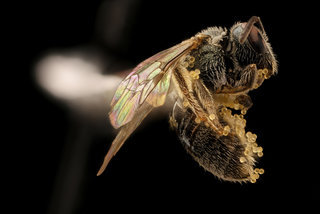
© Copyright source/photographer
· 5
Lasioglossum hitchensi, f, right side, Columbia, PA |
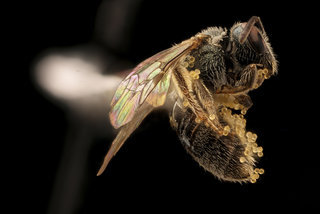
© Copyright source/photographer
· 5
Lasioglossum hitchensi, f, right side, Columbia, PA |
|
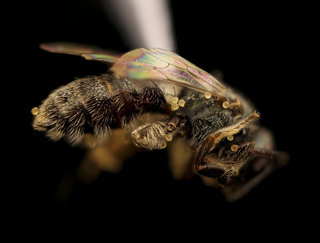
© Copyright source/photographer
· 5
Lasioglossum hitchensi, f, right side, PA, Columbia |
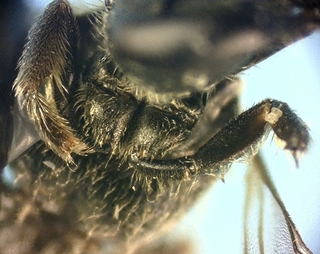
Deana Crumbling · 1
Lasioglossum hitchensi, female, forecoxa |
|
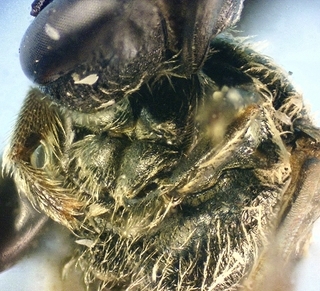
Deana Crumbling · 1
Lasioglossum hitchensi, female, forecoxa |
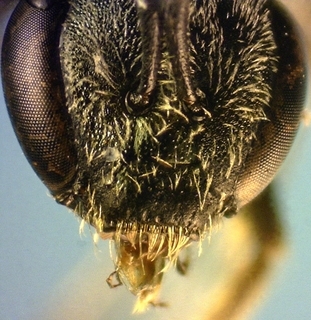
Deana Crumbling · 1
Lasioglossum hitchensi, female, forecoxa |
|
Overview |
Retrieved from: Gibbs, J. 2010. Revision of the metallic species of Lasioglossum (Dialictus)in Canada (Hymenoptera, Halictidae, Halictini). Zootaxa; 2591, 194-198
Dialictus atlanticus Mitchell, 1960: 383. ♀. (Preocc. Cockerell 1938b) Holotype. ♀ USA, North Carolina, Raleigh, 5.viii.1957 (Mitchell); [NCSU]. Examined.
Taxonomy. Knerer and Atwood, 1966a: Dialictus atlanticus ♂, p. 881; Krombein, 1967: Lasioglossum (Dialictus) atlanticum, p. 462 (catalogue); Hurd, 1979: Dialictus atlanticus, p. 1964 (catalogue); Moure & Hurd, 1987: Dialictus atlanticus, p. 91 (catalogue).
Diagnosis. Females of L. mitchelli can be recognised by the shape of the clypeus which has subparallel apicolateral margins, acute apicolateral angles and a broad, straight distal margin. They may be further distinguished by the round head (length/width ratio = 0.900.94), tessellate mesoscutum with moderately dense punctures on the central disc (i=11.5d), rugulose mesepisternum, pale tegula, and complete T1 acarinarial fan. They are most similar to L. weemsi which have a dorsal opening on the T1 fan. Lasioglossum mitchelli is also similar to some members of the L. viridatum species-group such as L. admirandum and L. paradmirandum. Females of the L. viridatum species-group have the clypeus distinctly convergent towards the apex and a distinct dorsal opening of the acarinarial fan.
Males of L. mitchelli are similar to females but have a more elongate head length/width ratio = 0.981.00) and may be further distinguished by the elongate flagellomeres (length/width ratio = 1.731.90), brownish yellow tarsi and tibial apices, weakly carinate posterior margin of the metapostnotum, and impunctate apical impressed areas of the metasomal terga. Males are most similar to L. versatum and L. paradmirandum. Male L. versatum have distinct punctures on the apical impressed areas of the metasomal terga. Male L. paradmirandum have the posterior margin of the metapostnotum rounded.
Redescription. FEMALE. Length 4.705.67 mm; head length 1.221.54 mm; head width 1.301.63 mm; forewing length 3.424.03 mm.
Colouration. Head and mesosoma green with faint bluish reflections to mostly blue. Clypeus with apical half blackish brown. Antenna dark brown, flagellum with ventral surface ruddy. Mesoscutum sometimes with brassy reflections. Tegula amber to reddish. Wing membrane subhyaline, venation and pterostigma brownish yellow. Legs brown, tarsi reddish brown to amber. Metasoma dark brown, terga and sterna with apical margins translucent brownish yellow.
Pubescence. Dull white. Moderately sparse. Head and mesosoma with moderately sparse woolly hairs (1 2 OD), longest on genal beard, metanotum and mesopleuron (22.5 OD). Paraocular area with moderately sparse tomentum, partially obscuring surface. Gena with sparse tomentum. Propodeum with moderately dense plumose hairs on lateral and posterior surfaces (22.5 OD). Metasomal terga with moderately sparse, fine setae. T1 acarinarial fan complete. T3T4 basolaterally and T5 entirely with sparse tomentum. T2 apicolateral and T3T4 apical margins with sparse fringes.
Surface sculpture. Face imbricate, punctation fine. Clypeus with apical half polished, punctation sparse (i=13d). Supraclypeal area with punctation moderately sparse (i=12.5d). Lower paraocular area punctation dense (i≤d). Antennocular area punctation moderately dense (i=11.5d). Upper paraocular area and frons punctate-reticulate. Ocellocular area obscurely punctate (i=d). Gena lineolate. Postgena imbricate. Mesoscutum tessellate, punctation moderately dense between parapsidal lines (i=11.5d), dense laterad of parapsidal lines (i≤d), contiguous on anterolateral portion. Mesoscutellum similar to mesoscutum, submedial punctation sparse (i=25d). Axilla minutely punctate. Metanotum imbricate. Preλpisternum rugose. Hypoepimeral area strongly imbricate. Mesepisternum dorsal half rugulose, ventral half ruguloso-imbricate. Metepisternum with dorsal two-fifths striate and ventral portion imbricate. Metapostnotum incompletely striate, posterior margin imbricate. Propodeum with dorsolateral slope rugulose, lateral surface tessellate-imbricate, posterior surface tessellate. Metasomal terga faintly coriarious, punctation uniformly spaced on disc (i=11.5d) except apical impressed area nearly impunctate.
Structure. Head very wide (length/width ratio = 0.900.94). Eyes convergent below (UOD/LOD ratio = 1.241.33). Clypeus ½ below suborbital tangent, apicolateral angle subparallel. Antennal sockets close (IAD/ OAD < 0.5). Frontal line carinate, ending 2 OD below median ocellus. Gena narrower than eye. Inner metatibial spur pectinate with 34 teeth. Metapostnotum truncate (MMR ratio = 1.211.35), posterior margin weakly angled onto posterior surface. Propodeum with oblique carina absent, lateral carina not reaching dorsal margin.
MALE. Similar to female except for the usual secondary sexual characters and as follows. Length 4.03 4.70 mm; head length 1.271.34 mm; head width 1.301.37 mm; forewing length 3.363.48 mm
Colouration. Labrum, mandible, flagellum ventral surface, tibial bases and apices, and tarsi yellow to brownish yellow.
Pubescence. Lower paraocular area with appressed tomentum obscuring surface. Clypeus, and supraclypeal area with sparse tomentum not obscuring surface. S3S4 apicolateral portions with moderately dense tufts (11.5 OD).
Surface sculpture. Mesoscutum densely imbricate. Metanotum rugulose. Metapostnotum coarsely, longitudinally striate. Propodeum with dorsolateral slope rugose. Metasomal terga with apical impressed area impunctate.
Structure. Head round (length/width ratio = 0.981.00). Eyes strongly convergent below (UOD/LOD ratio = 1.551.57). Antennal sockets distant (IAD/OAD > 1.6). Frontal line carinate, ending 2 OD below median ocellus. Pedicel shorter than, or subequal to, F1. F2 length 1.92.0X F1. F2F10 elongate (length/width ratio = 1.731.90). Metapostnotum truncate (MMR ratio = 1.201.50), posterior margin sharply angled onto posterior surface.
Terminalia. S7 with median lobe clavate, sides concave, apex rounded (Fig. 147G). S8 with apicomedial margin weakly convex (Fig. 147G). Genitalia as in Fig. 147EF. Gonobase with ventral arms widely separated. Gonostylus small, dorsal setae elongate. Retrorse lobes elongate, narrow, weakly attenuated apically.
Range. Ontario south to Georgia, west to Kansas (Fig. 143).
Additional material examined. CANADA: ONTARIO: 2♀♀ Iona, 17.ix.1963, on Solidago, (G. Knerer); 1♂, Iona, 15.ix.1963 (G. Knerer); 2♀♀ Iona, 25.v.1962 (G. Knerer); 1♀ Ipperwash, 25.v.1962 (G. Knerer); [ROM]; 1♀ Ojibway Park, nr. Windsor, 24.viii.1982 (M. Sharkey); [PMAE]; [PCYU]; USA: ILLINOIS: 8♀♀ Carlinville, N39.1365 W089.9419, 24.vi.2006 (J. Gibbs); 3♀♀ Carlinville, N39.2787 W089.7961, 25.vi.2006 (J. Gibbs); 5♀♀ Carlinville, N39.3018 W089.7886, 26.vi.2006 (J. Gibbs); 3♀♀ E of Carlinville, N39.2596 W089.5485, 25.vi.2006 (J. Gibbs); 2♀♀ Litchfield, N39.1484 W089.66696, 25.vi.2006 (Gibbs & Sheffield); 1♀ Macoupin Co., E of Carlinville, N39.27869 W089.7961, 25.vi.2006 (C. Sheffield); 1♀ Montgomery Co., N39.25962 W089.54851, 25.vi.2006 (Gibbs & Sheffield); [PCYU]; IOWA: 1♀ Mahaska Co., Oskaloosa, 21.viii.1964 (A.R. Moldenke); [AMNH]; KANSAS: 1♂ Douglas Co., Coyler Prairie, N38°49.168΄ W095°21.788΄, 11.vii.2004 (J. Hopwood); 1♀ Douglas Co., Coyler Prairie, N38°49.168΄ W095°21.788΄, 28.vii.2004 (J. Hopwood); MARYLAND: 1♀ 3.ix.2003 (S.W. Droege); 1♀ Frederic Co., Creagerstown Park, Hwy 550 & Monocacy River, N39.6153 W077.3506, 10.vi.2006 (J. Gibbs); 1♀ Montgomery Co., N38.97 W077.1565, 24.vi.2006 (S.W. Droege); MICHIGAN: 1♀ Olivet, N42.4129 W084.9386, 27.vi.2006 (J. Gibbs); NEW YORK: 3♀♀ Tompkins Co., Bakers, N Lansing, 15.v.2009 (B.N. Danforth); [CUIC]; NORTH CAROLINA: 1♀ Great Smoky Mtn. N.P., Cataloochee, N35.62813 W083.09997, 6.viii.2006 (J. Gibbs); [GSNP]; 1♂ Hwy 24/27, E of Charlotte, N35.24474 W080.53715, 10.viii.2006 (C. Sheffield); 1♀Mechlinburg Co., Huntersville, 8.vii2006 (M.F. Veit); SOUTH CAROLINA: 1♀ Okanee Co., nr Walhalla, N34.81283 W083.13679, 9.viii.2006 (J. Gibbs); [PCYU]; TENNESSEE: 6♀♀ Great Smoky Mtn. N.P., Cades Cove, Hyatt Rd at Abhrams Creek, 5.viii.2006 (J. Gibbs); [GSNP]; TEXAS: 1♀ Bastrop Co., Stengl Biological Stn., 6 mi N of Smithville, 12.v.2000 (J. Abbott & R. Caesar); [PCYU]; 1♀ Bastrop Co., Stengl Biological Stn., N30.087 W091.173, 5.v.2005 (A.W. Hook); [CTMI]; VIRGINIA: 1♀ Albemarle Co., N37.8479 W078.6679, 14.iv.2003 (T. Olivier); 2♀♀ Assateague I., N37.9144 W075.3379, 30.vi1.vii.2006 (S.W. Droege); WEST VIRGINIA: 1♂ Hampshire Co., N39.3353 W078.456, 17.ix.2005 (S.W. Droege); [PCYU]; WISCONSIN: 1♀ Dane Co., Westport Drumlin, 11.vii.1996 (R.A. Henderson); [IRCW].
Floral records. APIACEAE: Eryngium yuccifolium, APOCYNACEAE: Apocynum cannabinum, ASTERACEAE: Cichorium, Solidago, Taraxacum officinale, Vernonia,BRASSICACEAE: Barbarea vulgaris, FABACEAE: Amorpha canescens, A. fruticosa, Dalea purpurea, Glycine max, Melilotus officinalis, RANUNCULACEAE: Ranunculus abortivus.
Etymology. The specific epithet is named in honour of Theodore B. Mitchell.
Comments. Rare in Canada. Abundant in the Eastern USA. It has sometimes been mistaken in collections for L. admirandum. Lasioglossum interruptum (Panzer) is a subjective senior synonym of Halictus interruptus atlanticus Cockerell. The name Lasioglossum atlanticum (Mitchell), used in the past, is unavailable due to secondary homonymy (Ebmer 1976).
|
|
|
Identification | |
Extracted by Gibbs J., 2011. Revision of the metallic Lassioglossum (Dialictus) of the eastern North American (Hymenoptera: Halictidae: Halictini). Zootaxa.
Diagnosis. Female L. mitchelli can be recognised by the shape of the clypeus, which has the distal margin beyond the preapical fimbriae extending laterally making it noticeably wider than the preapical margin (Fig. 21B). The distal portion of the clypeus has a rectangular appearance as a result. They may be further distinguished by the combination of head wide (length/width ratio = 0.900.94); mesoscutum tessellate, punctures moderately dense between parapsidal lines (i=1 1.5d); mesepisternum rugulose; tegula pale straw; T1 declivitous surface with distinct, coriarious microsculpture, and acarinarial fan usually without dorsal opening. They are similar to some members of the L. viridatum species-group such as L. paradmirandum. Females of the L. viridatum species-group have the clypeus distinctly convergent towards the apex, T1 is often polished and the acarinarial fan usually has a distinct dorsal opening.
Male L. mitchelli are similar to females but have a more elongate head length/width ratio = 0.981.00) and may be further distinguished by flagellomeres elongate (length/width ratio = 1.731.90), tarsi and tibial apices brownish yellow, metapostnotum with posterior margin weakly carinate, and apical impressed areas of metasomal terga impunctate. They are most similar to L. versatum and L. paradmirandum. Male L. versatum have distinct punctures on apical impressed areas of metasomal terga. Male L. paradmirandum have posterior margin of metapostnotum rounded.
|
|
|
Names | |
|
|
| Supported by | |
Updated: 2024-07-27 01:34:48 gmt
|